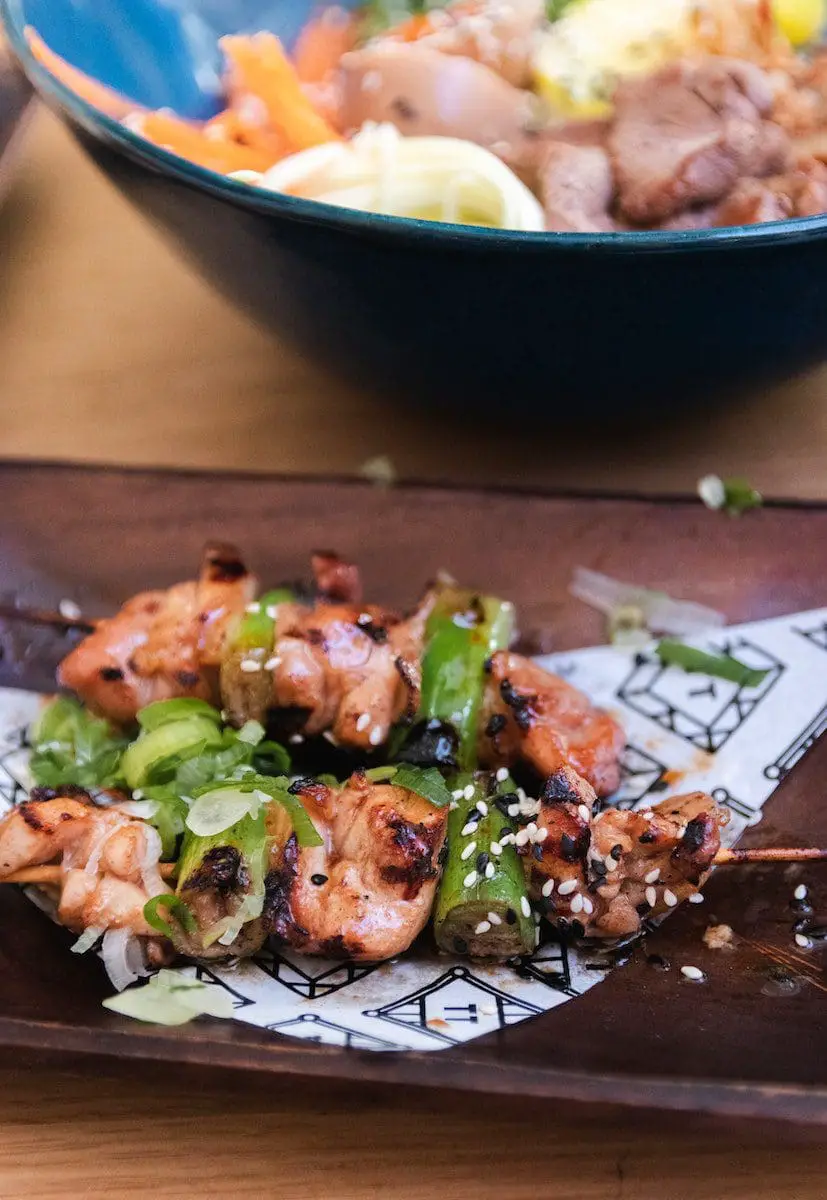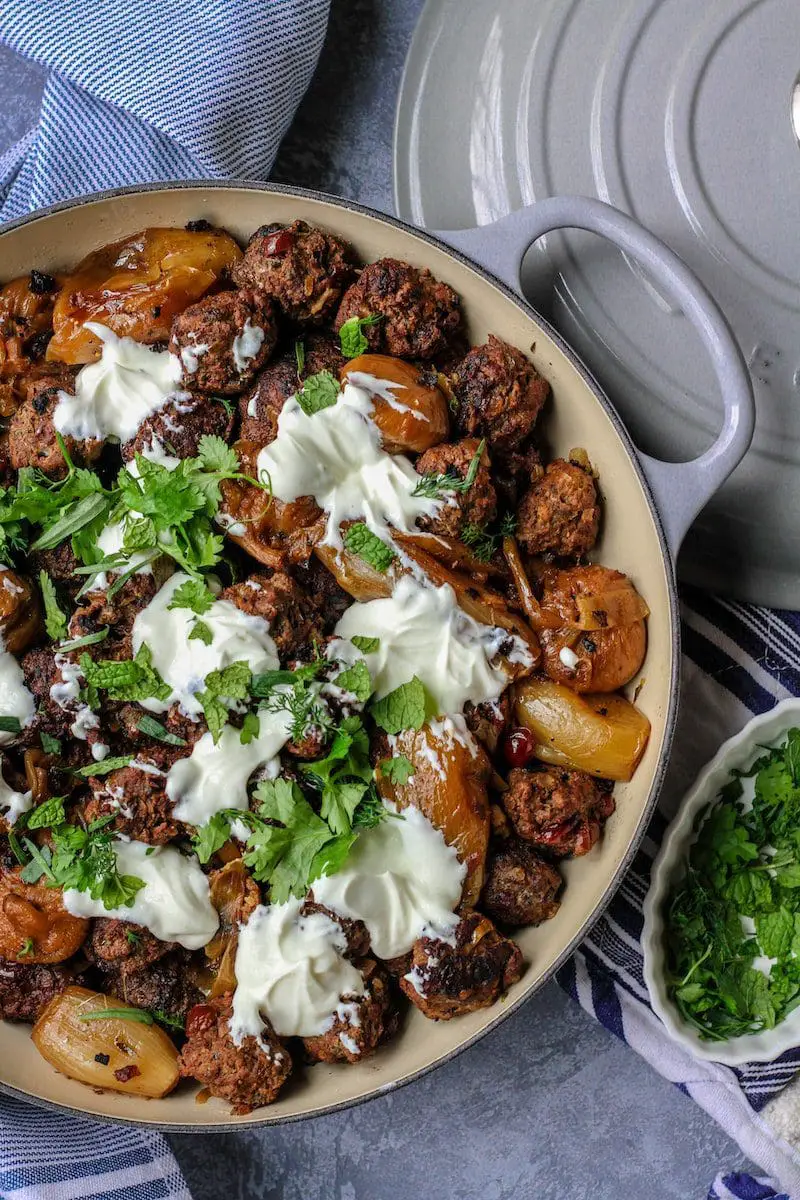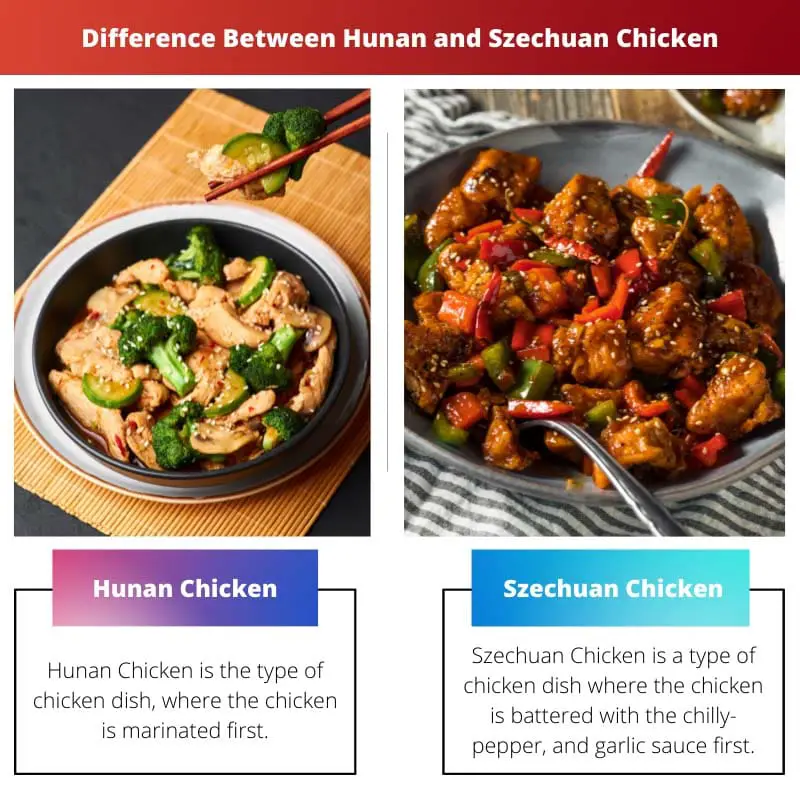Non-vegetarian cuisine has a wide variety of food items. It has gained popularity over the years across the globe mainly because of three reasons, the first of which is that its rich in proteins, inexpensive and has different recipes and styles to prepare. Even one food item, such as chicken, has several recipes, such as grilled, spicy, butter, etc.
Szechuan and Hunan chicken are two recipes of one food item, i.e. chicken. Chicken. Chicken has several health benefits attached to it, such as it is rich in proteins, good for the heart, helps to boost metabolism, is a natural antidepressant, and is rich in selenium, phosphorous, and niacin; it also promotes eye health, and body tissues, and helps to prevent bone loss.
Key Takeaways
- Hunan chicken originates from the Hunan province in China and features a spicy, savory flavor profile with fresh chili peppers and a hint of sourness.
- The Szechuan chicken comes from the Sichuan province in China and is known for its bold, spicy flavors, incorporating Sichuan peppercorns for a unique numbing sensation.
- Both dishes showcase Chinese regional cuisine and incorporate spicy flavors but differ in taste, ingredients, and the type of heat they provide.
Hunan vs Szechuan Chicken
Hunan chicken is a popular Chinese dish made with a mix of vegetables and known for its smoky, spicy and “dry heat” flavour. Szechuan Chicken is also a popular Chinese dish, but it is characterized a fiery and mouth-numbing spiciness sensation from the use of Szechuan peppercorns.

Comparison Table
| Parameter of Comparison | Hunan Chicken | Szechuan Chicken |
|---|---|---|
| First-step | Hunan Chicken is a chicken dish where the chicken is first marinated. | Whereas Szechuan Chicken is a type of chicken dish where the chicken is first battered with the chilly-pepper and garlic sauce. |
| Place of origination | Hunan cuisine originated from the Sichuan Province of South-Western China. | Whereas, Szechuan cuisine originated in the Xiang River region, Dongting Lake, Western Hunan Province of China, |
| Flavour | Hunan Chicken has more oil and is spicier than Szechuan chicken. | On the other hand, Szechuan chicken is a sweet and spicy dish with solid flavours. |
| Recipe | The vegetables are stirred first, and then the rest of the ingredients are added along with the marinated chicken. | In the Szechuan recipe, the battered chicken is fried first, then the vegetables are fried, and in the end, the other ingredients are added and stir-fried. |
| Cuisine | Hunan chicken is a part of Xiang, or Hunan Cuisine. | On the other hand, Szechuan chicken is a part of Szechuan cuisine. |
What is Hunan Chicken?
Hunan cuisine, also known as Xiang cuisine, comprises cuisines from the Xiang River Region of the Western Hunan province of China. Hunan cuisine is one of the eight traditional Chinese cuisines and is famous worldwide for its hot and spicy flavour.
Hunan Cuisine is well-known for its aromatic spiciness and sourness, as pepper is the key ingredient of the cuisine. Its famous dishes include a steamed fish head with chopped chilli, fried pork with chillies, lobster, tofu, Hunan rice noodles, spicy salted duck, etc.
The raw ingredients of the cuisine are well-matched so that different tastes of the ingredients complement each other, so the result is tasty. The food is cooked with more oil than in Szechuan cuisine and appears darker than in any other cuisine.
The recipe for Hunan Chicken is as follows:
- Add 1/4th cup of cornstarch in a bowl, then season it with salt and pepper. Add chicken pieces and toss to coat them well.
- Add all the ingredients for the sauce into another bowl, and whisk until combined well.
- Put a large pan on medium flame, add vegetable oil and chicken pieces; cook them nicely until golden brown, and put the chicken aside once cooked.
- Pour 2-3 tablespoons of oil into the pan, and add vegetables; cook them for another 7-8 minutes.
- Add the chicken and the sauce into the pan, and stir well to coat the chicken.
- Remove the pan from the heat, and serve with white rice.
- Last but not least, garnish it with sesame seeds and green onions.

What is Szechuan Chicken?
Szechuan cuisine, also known as Sichuan cuisine or Szechwan cuisine, is one of the famous cuisines across the world and is a Chinese cuisine that comes from the Sichuan province of China. Popular meals of Szechuan cuisine are spicy diced chicken, twice-cooked pork, fish-flavoured pork sauce, and Szechuan chicken.
Moreover, all the meals have pungency and spiciness in common, which is a result of the abundance usage of garlic and chilli peppers combined with a distinctive flavour of Szechuan sauce.
Sichuan has poor weather, high humidity level, and a lot of rainy days, which makes the usage of red chilli pepper vital as the red chilli pepper is known to reduce internal dampness.
Moreover, the humid climate makes the people implement many preservation techniques, including salting, drying, pickling, and smoking food. Szechuan cuisine is not only famous for its spicy but also for its fish, as well as beef dishes.
Sichuan is known to have an abundance of oxen in the region, which paves the way for many beef dishes.
Szechuan’s menu keeps on changing depending upon the season; for example, cold meats with peppers help the locals to keep themselves cool in the summer season, whereas, on the other hand, hot and spicy food during the winter season helps to keep themselves warm.
The recipe for the Szechuan Chicken is as follows:
- Put chicken and 1/4th cup of cornstarch into a large reusable bag, season it with pepper and then shake to coat the chicken.
- Put a medium or high flame pot and pour enough oil into frying the chicken.
- In a large pot, pour 1-2 tablespoons of oil, add ginger and garlic paste, and cook until they turn light brown; add bell pepper and cook for another 5-7 minutes, then add dried chilli and stir.
- Pour some soya sauce, rice wine vinegar, chilli garlic sauce, and sesame oil into a small saucepan, and whisk with the remaining cornstarch until thickened.
- Add chicken to the large pot, and mix well. Lastly, garnish it with sesame seeds over the rice.

Main Differences Between Hunan and Szechuan Chicken
- Hunan Chicken, also known as Xiang, is identified as a meal with a more specific taste than that of Szechuan Chicken.
- Hunan chicken is known for its dry, purely hot, and oilier state, whereas, on the other hand, Szechuan is less spicy than Hunan and has a strong flavour of spices.
- Hunan cuisine originated in the Xian River Region in the Western Hunan province of China. In contrast, on the other hand, Szechuan cuisine originated in the Szechuan province of South-Western China.
- Unlike Hunan Chicken, Szechuan has a unique flavour of Sichuan peppercorn, a strong taste of spices, and citrus-like spice.
- Peanuts, sesame paste, and ginger are essential in the Szechuan recipe, whereas the Hunan recipe mixes fresh ingredients and smoked chicken.


The detailed recipes for Hunan chicken and Szechuan chicken have added a practical dimension to this article. It’s wonderful to have access to authentic recipes to try at home.
Absolutely, the inclusion of step-by-step recipes is a standout feature of this post. It makes the culinary experience more accessible and enjoyable.
The comparison of Hunan and Szechuan chicken has been presented with such clarity and attention to detail. It’s a well-structured and insightful analysis.
Absolutely agree, the thorough comparison is indicative of extensive research and knowledge. It’s a valuable contribution to understanding Chinese regional cuisines.
The precision in presenting the differences between these two dishes is indeed impressive. It has elevated the understanding of Chinese culinary varieties.
Learning about the unique characteristics of Hunan and Szechuan cuisine has been captivating. The article has provided a great deal of insight into these regional delicacies.
I couldn’t agree more. Exploring the distinct traits of different cuisines is always intellectually stimulating, and this post has certainly succeeded in that aspect.
The detailed exploration of Hunan and Szechuan cuisine has been intellectually enriching. It’s a testament to the diverse and fascinating world of culinary traditions.
Absolutely, the diverse range of flavors and traditions in Chinese cuisine is truly captivating. This article has done a great service in bringing these nuances to light.
Agreed, the article’s focus on the richness of Chinese culinary heritage is commendable. It’s a delightful exploration of regional cuisines.
The in-depth explanations of Hunan and Szechuan chicken have been both educational and engaging. It’s a wonderful blend of culinary knowledge and cultural insight.
The comprehensive portrayal of Hunan and Szechuan chicken has been a delightful read. It’s a testament to the richness of Chinese culinary diversity.
Absolutely, learning about the culinary subtleties of different regions is always an intellectually rewarding experience. This article has certainly delivered on that front.
The health benefits associated with consuming chicken make it an even more attractive food option. This article has shed light on the nutritional aspects of non-vegetarian cuisine.
Absolutely, the information about the health benefits of chicken is very interesting and makes non-vegetarian cuisine more appealing.
The variety of flavors and cooking methods of non-vegetarian food items is really fascinating. I appreciate the detailed comparison between Hunan and Szechuan chicken, it’s very informative and has made me want to try both dishes.
I’m glad the article provided detailed recipes for both Hunan and Szechuan chicken. It’s great to have the opportunity to cook these at home.
It is indeed intriguing to learn about the nuances of different cuisines. The detailed comparison really adds depth to the understanding of these dishes.
The comprehensive comparison table clearly outlines the key differences between Hunan and Szechuan chicken. It’s a great visual aid to understand their distinctions.
I agree, the table format helps in summarizing the disparities effectively. It’s a valuable addition to the article.
The historical and cultural information about Hunan and Szechuan cuisine has been presented with great depth. It’s refreshing to see such a well-rounded exploration of these culinary traditions.
The historical insights bring an engaging narrative to the article. It’s an intellectually satisfying read.
Indeed, the article’s attention to the cultural context and origin of these dishes is commendable. It adds a layer of richness to the overall understanding.
I am surprised to find out that Hunan and Szechuan chicken are so distinct in terms of their origin, flavor, and recipe. The depth of this comparison is enlightening.
Yes, it’s always enriching to explore the intricate differences between various regional cuisines. This article has done an excellent job in highlighting these nuances.